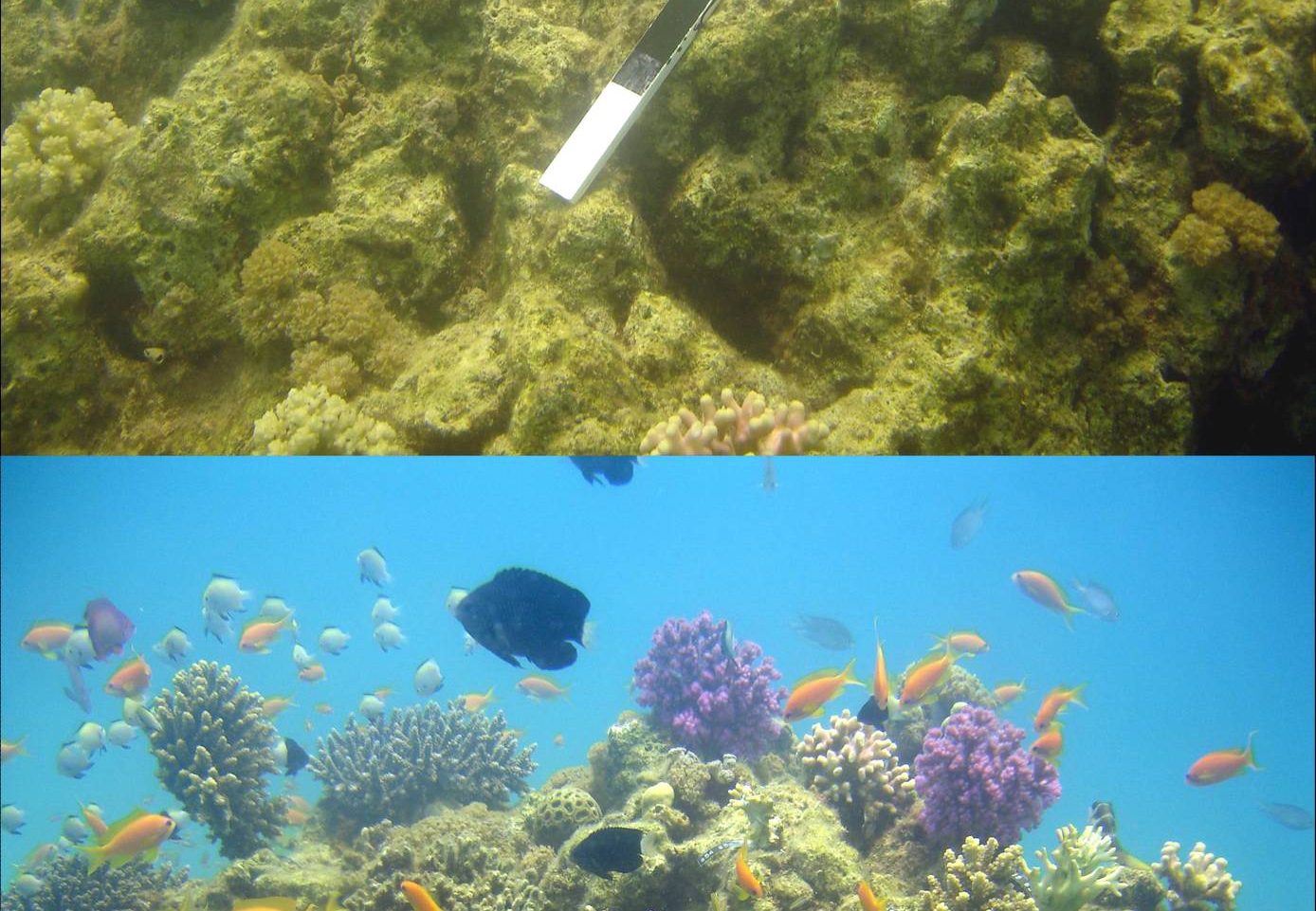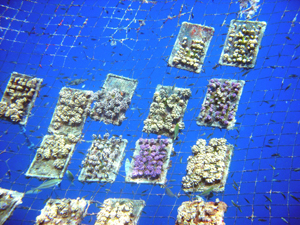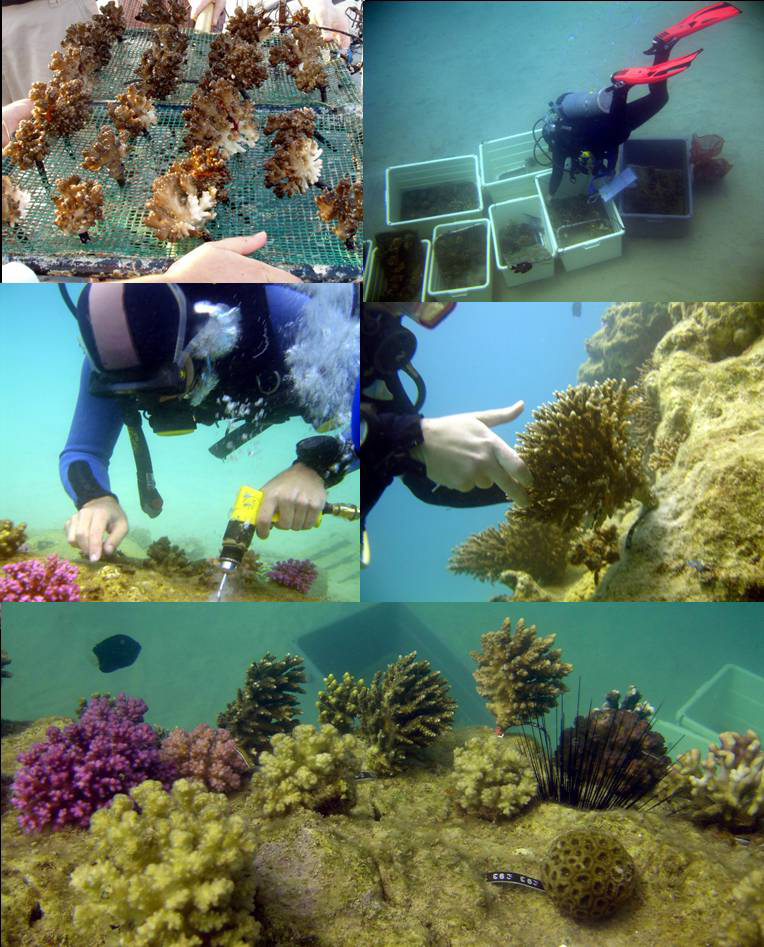Overview
Like many of the world’s coral reefs, the Gulf of Eilat reef system in the northern Red Sea has been severely degraded by a combination of anthropogenic pressures and changing global conditions. Due to its increasing fragility and inability to cope with further disturbances, the Eilat reef has been targeted for active restoration. Citing the ineffectiveness and impracticality of traditional coral transplantation techniques, project planners developed and implemented a new “coral gardening” method at Eilat. In situ, floating coral gardens were created using a flexible rope net to which coral fragments were affixed. Safe from predation and disturbance, the coral fragments quickly matured and were then transplanted into denuded areas of the reef. Observations thus far indicate that the gardening technique holds promise for quickly rearing adaptable, resilient coral gardens without causing heavy damage to donor sites or wasting time and resources on transplantation efforts that ultimately fail.
Quick Facts
Project Location:
Gulf of Eilat, 28.6929261, 34.729876500000046
Geographic Region:
Middle East
Country or Territory:
Israel
Biome:
Coastal/Marine
Ecosystem:
Coral Reef, Seagrass & Shellfish Beds
Organization Type:
NGO / Nonprofit Organization
Location
Project Stage:
Planning / Design
Start Date:
2007-08-13
End Date:
2007-08-13
Primary Causes of Degradation
Urbanization, Transportation & IndustryDegradation Description
Reef degradation in this part of the northern Red Sea has proceeded gradually over the last four decades and has resulted from heedless development of the city of Eilat; eutrophication from intermittent municipal sewage outflow and mariculture activities; contamination from industrial installations; tourist activities; and other anthropogenic causes (e.g. frequent oil spills). Globally related phenomena (e.g. changing climatic conditions) have probably also played a role in the degradation of the Eilat reef system.
Reference Ecosystem Description
Although situated along the most northern boundaries of coral reef distribution, the pristine reefs of the northern Gulf of Aqaba (ca. 30°N), along the shorelines of the Sinai Peninsula, exhibit extraordinary high within-habitat coral species diversity (sensu MacArthur 1972), among the highest in the world.
Project Goals
– To restore the reef of Eilat using coral transplants reared in a newly developed floating nursery
– To assess the practicality of floating nurseries for reef restoration projects elsewhere in the world
Monitoring
The project does not have a monitoring plan.
Description of Project Activities:
In past restoration projects, whole coral colonies or coral ramets have been taken from healthy localities and transplanted into denuded areas. The low survival rates of these transplants and the stress caused to donor colonies have proven this method ineffective. Therefore, this project incorporated a new method, the "gardening coral reefs concept," that uses forest restoration techniques to improve the overall effectiveness of coral reef restoration. The method consists of two steps: 1) generating and culturing minute coral recruits (i.e. spats, nubbins, coral fragments and small coral colonies) in an in situ, floating nursery; and 2) transplanting these colonies, when mature, in the degraded reef.
For this project, a mid-water, floating nursery was installed in a sheltered zone away from major natural reef areas, where it could have been damaged by tourists' activities and/or corallivorous organisms. The nursery was established at the Ardag fish farm facility, located at the northern shore of the Gulf of Eilat, Red Sea (29º32.45'N, 34º58.40'E), at a depth of 6m (14m above the sea bottom). The nursery consisted of a flexible rope net (10X10 meter size, 100 cm2 hole size) tied to cables anchoring a large fish cage (containing gilthead seabream, Sparus aurata).
Ramets from coral branching forms were pruned to small size fragments (0.5-2 cm high) and nubbins by the use of an electrician's wire cutter. Old and recently developed parts of each colony, as well as tip and mid-branch zones, were used as source material for fragment preparation. All colonies and colony fragments were collected from artificial substrates at the northern part of the Gulf and transported (submerged in seawater) to the nursery site.
Coral ramets and colonies were then affixed to plastic nets (0.25 cm2 mesh size) that were stretched over PVC frames (each 50X30 cm). These frames, with the attached coral, were tied to the rope net. In the nursery, almost 8000 coral fragments and colonies, positioned on ca. 80 plastic frames, were maricultured.
Once they reached maturity, five hundred and fifty nursery-grown colonies of two branching stony corals--Stylophora pistillata; Pocillopora damicornis-- were transplanted on several shallow-water, denuded knolls at 7-13m depth.
Ecological Outcomes Achieved
Eliminate existing threats to the ecosystem:
The results of the first ten monitoring months revealed low mortality rates for the new transplants. The transplanted colonies of both species were immediately colonized by coral-obligatory invertebrates including: Trapezia crabs, Spirobranchus worms and Alpheus shrimps. We also followed the transplantation's influence on the local fish community, witnessing an increase in species richness. Because the transplanted corals create new spatial and ecological niches for marine invertebrates and fish, they should stimulate a resurgence of reef-associated fauna. Furthermore, they can also be expected to increase the settlement of new coral colonies, as larvae tend to settle in areas where adult colonies already exist or in areas with exposed coral skeleton. Not only that, the transplanted colonies will also contribute to and enhance the local larval pool by participating in the reproductive process.
Factors limiting recovery of the ecosystem:
Many of the Stylophora transplants were surprisingly attacked by local fish (i.e. butterfly fish grazed on polyps, parrotfish damaged colonies by breaking whole branches). Fish attacks were rarely documented on Pocillopora colonies. Most damaged colonies survived, and with time, a large portion of the damaged colonies have started to regenerate lost parts.
Socio-Economic & Community Outcomes Achieved
Key Lessons Learned
This restoration technique has several advantages. First, transplanting new, whole colonies, rather than coral fragments, substantially increases their ability to acclimate to the new environment. It also reduces the stressed caused to donor colonies, as the new colony is reared from nubbins (1-10 polyps). Finally, the generation of thousands of new colonies allows for a rapid, larger-scale restoration.
Based on the studies conducted thus far, floating nurseries have been found to have several advantages over bottom nurseries: 1. Water flow: Increased water flow supplies the mid-water nursery system with large quantities of plankton particles, probably enhances the dissolved oxygen flow around the coral tissue, and helps remove mucus secreted by the coral tissue more efficiently; 2. Movement of the nursery: In sea bottom nurseries attached to the reef floor, water movement around the corals results strictly from currents or wave action. In a mid-water floating nursery, the whole nursery moves in the seawater column in all directions. This flexibility enables the nursery to further increase water exchange around the coral tissue and promotes a better elimination of debris, sedimentation particles and other settling material that might accumulate on developing coral colonies; 3. Sedimentation: One of the obstacles of raising coral colonies in affixed, substrate nurseries is the detrimental effect of sedimentation that may negatively influence the health and growth of corals. In the current mid-water nursery, the sea floor was 14 m down, and sedimentation was significantly reduced; 4. Photosynthesis activities: Mid-water nurseries can be depth adjusted according to the needs of each specific coral species. 5. Reduction in coral predators and other stressors: Shallow-water, sea-bottom nurseries are usually situated near natural reefs. This exposes them to corallivorous fish and invertebrates as well as to impacts from divers in tourist areas. Installing the nursery at a distance from the reef reduces the potential for harmful impacts from predators and recreational activities.
Although there are still many unknowns (e.g., multi-layer nursery, optimal nursery time and seasonality, optimal fragments size, number of ramets per genet, active maintenance, etc.), it is evident that the ability to produce and develop numerous coral colonies by means of this method may change the way end-users manage denuded reef areas.
Long-Term Management
Monitoring at the site will continue in order to provide data on the survival rates of the transplants, their acclimatization and overall impacts on the environment.
Other Resources
Yael Horoszowski
[email protected]




